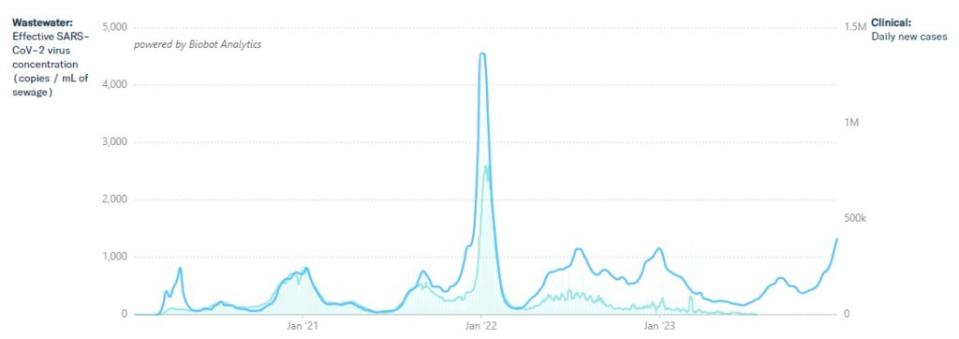Highly mutated COVID variant ‘Pirola’ JN.1 is fueling the pandemic’s second highest U.S. wave—and it’s still growing
COVID levels have reached their second-highest level of the pandemic in the U.S., according to federal wastewater data released Friday—this as related ER visits, hospitalizations, and deaths continue to rise.
National COVID wastewater levels sat at 12.85—the number of standard deviations above baseline—on Dec. 30, according to data from the U.S. Centers for Disease Control and Prevention. Until then, the pandemic’s second-highest peak had occurred on Dec. 31, 2022, during the XBB.1.5 “Kraken” surge, when levels sat at 10.16.
The pandemic’s all-time high still looms further upward at 23.34—recorded on Jan. 8, 2022, at the height of the first Omicron wave.
With COVID testing at all-time lows, wastewater is now the best and quickest way to gauge the growth of the virus, experts say. Other indicators, like hospitalizations and deaths, only reflect the most severe cases and lag by several weeks.

This winter’s surge—fueled by the now globally dominant variant JN.1—has yet to crest. It likely will in a week or two, according to Jay Weiland, a variant forecaster with a reputation for high accuracy and veritably the only left in the business, at this late date.
Unfortunately, Biobot will not be providing an update this week due to holiday break. The CDC wastewater data from last Friday suggests:
🔸1,40,000 new infections/day
🔸1 in every 240 became infected today
🔸1 in every 24 people currently infected https://t.co/j09q3urs8b— JWeiland (@JPWeiland) January 2, 2024
COVID hospitalizations, too, are on the rise, up more than 20% week over week, according to new CDC data. Both COVID-related ER visits and deaths are up by roughly 13% as well.
Globally, JN.1 accounts for more than 40% of COVID sequences reported worldwide, according to outbreak.info, a collaborative effort supported by the U.S. National Institute of Allergy and Infectious Diseases. The variant began picking up steam globally last fall, and its growth skyrocketed upward in vertical fashion last month.
“This is what happens with an Omicron-like event of a new, hyper-mutated strain … picks up a critical added mutation, giving it huge growth advantage and fast rise to global dominance,” Dr. Eric Topol, founder and director of the Scripps Research Translational Institute in La Jolla, Calif., said via Twitter on Friday.
The JN.1 variant is completing its takeover in the United States, pegged at 62% of new cases in today's @CDCgov update (which is about 2 weeks behind actual d/t sequencing lag). It's also globally dominant.https://t.co/jjl2AnOYb5 pic.twitter.com/ATvp8ufP7M
— Eric Topol (@EricTopol) January 5, 2024
Pi, or just another Omicron spawn?
The news comes as experts debate whether JN.1—a descendant of the highly mutated Omicron spawn BA.2.86—represents a new chapter in the pandemic.
BA.2.86—and JN.1, by extension—is just as genetically divergent from the original Omicron as the original Omicron was from Wuhan strains, leaving some experts contending that the WHO should assign it a Greek letter of its own. It hasn't doled one out since B.1.1.529 received the designation of Omicron in November 2021.
Already, volunteer variant trackers have dubbed the BA.286 lineage "Pirola," after an asteroid located near Jupiter, because the name is nearly a mix of both Pi and Rho—the next letters the WHO might choose from.
Speaking exclusively to Fortune on Dec. 30, Maria Van Kerkhove, head of the WHO's emerging diseases and zoonoses unit, said the organization would assign a new Greek letter on a moment's notice, if necessary. But it's holding out for a variant that is "truly different," she said—one that impacts public health.
“If we were to see any change in severity, for example, we wouldn’t hesitate to call this a VOC, or the next one a VOC,” she said. “But phenotypically, we’re really seeing similar behavior to the other circulating variants.”
If the WHO assigned a new Greek letter to JN.1—or any other variant, for that matter—it wouldn’t mean an automatic renewal of the organization’s “public health emergency of international concern” status. Director General Tedros Adhanom Ghebreyesus could choose to summon an emergency committee at any time, for any reason. That committee would make the decision as to whether or not to renew COVID-19’s official pandemic status, which ended in May.
'A new era' in viral evolution
Regardless of whether JN.1 receives a Greek letter, it very likely represents a fresh chapter in pandemic evolution, many experts contend.
The highly mutated variant has ushered in “a new era,” Ryan Gregory—a biology professor at the University of Guelph in Ontario, Canada, and a lead variant tracker—recently told Fortune, and is “on track to become the lineage from which most variants are descended for the foreseeable future.”
Ryan Hisner—a top citizen variant tracker who discovered the second and third known cases of BA.2.86—says “Pirola” has brought about a startling realization: Omicron wasn’t a “one-off anomaly.”
“Ever since BA.1 emerged, people have asked whether the original Omicron event was essentially a freak accident or something we could expect to occur repeatedly in the future,” he recently told Fortune. “JN.1/BA.2.86 has really changed the outlook on this front. I think it’s now much more widely accepted that these extreme [evolutionary] events will be a semi-regular occurrence with SARS-CoV-2.”
Van Kerkhove agreed. “We could have the next sub-lineages come from JN.1,” she said. “But we could also see something quite different. We could see something like an Omicron again.”
This story was originally featured on Fortune.com
